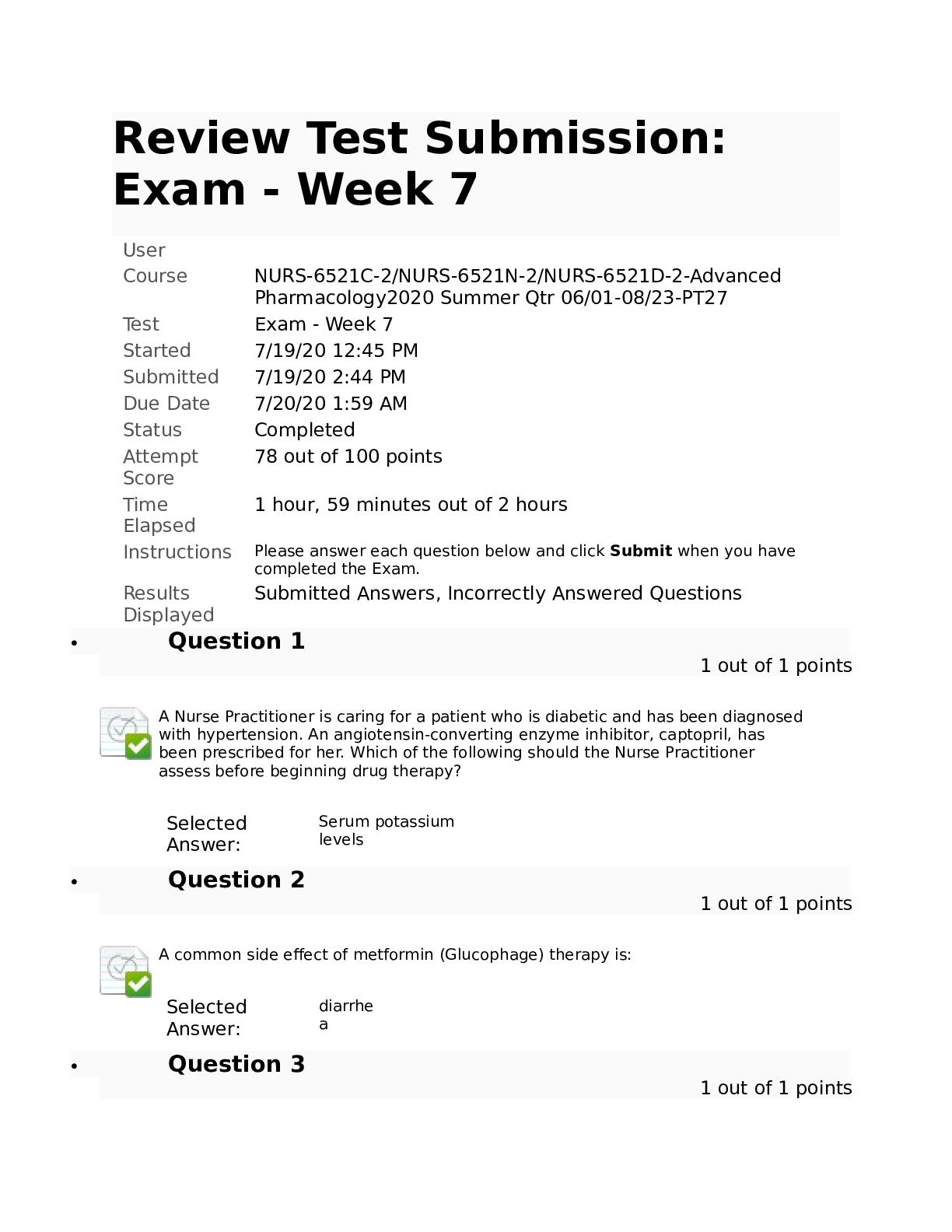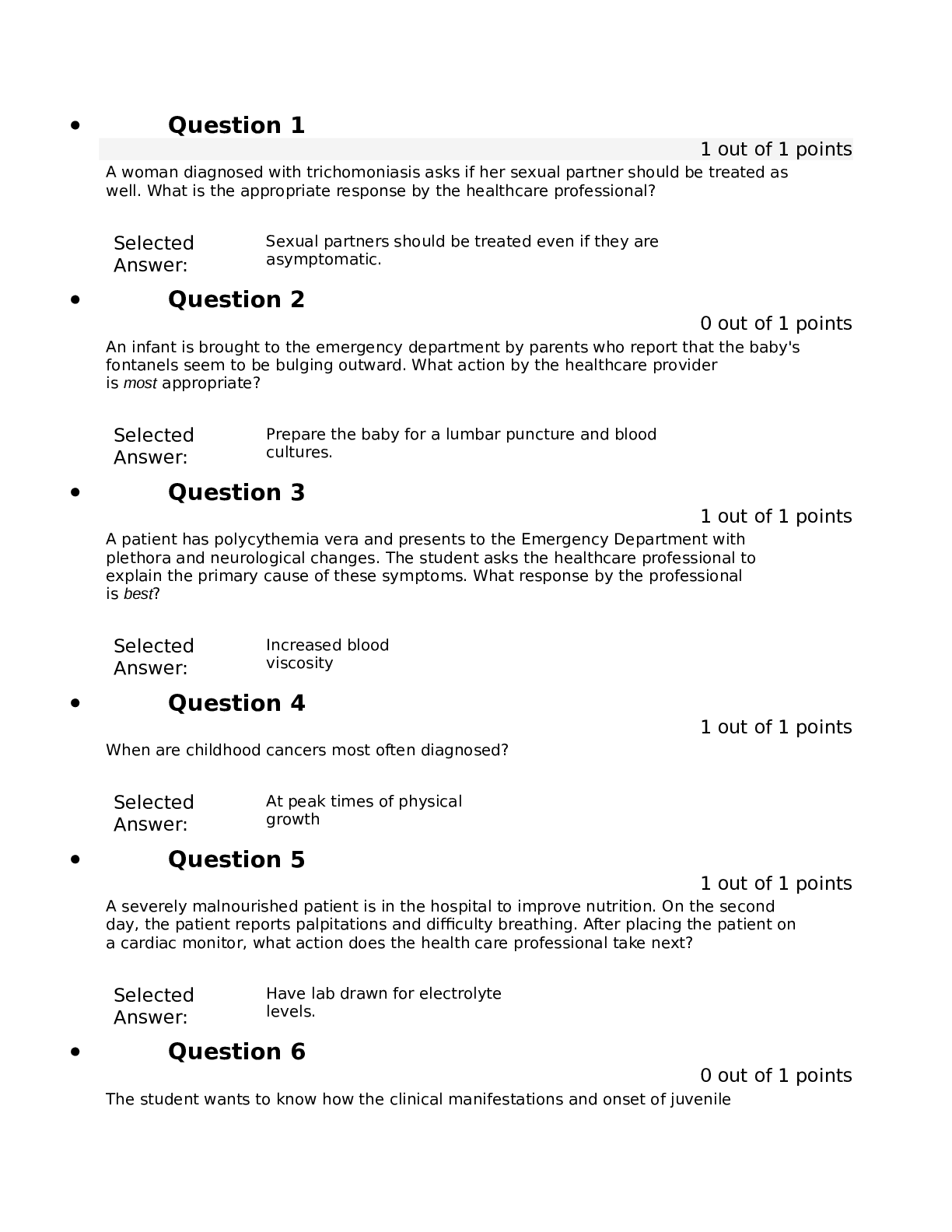*NURSING > QUESTIONS & ANSWERS > 6512 Review Test Submission- Final Exam - Week 11.]100 Q & A in Each Version| Verified and 100 % Cor (All)
6512 Review Test Submission- Final Exam - Week 11.]100 Q & A in Each Version| Verified and 100 % Correct]
Document Content and Description Below
Review Test Submission: Final Exam - Week 11 User Question 1 1 out of 1 points During chest assessment, you note the patient's voice quality while auscultating the lung fields. The voice s... ound is intensified, there is a nasal quality to the voice, and the e's sound like a s. This sound is indicative of: Selected Answer: lung consolidation. Question 2 1 out of 1 points As Mr. B. enters the room, you observe that his gait is wide based and he staggers from side to side while swaying his trunk. You would document Mr. B.'s pattern as: Selected Answer: cerebellar ataxia. Question 3 1 out of 1 points 2 Diabetic peripheral neuropathy will likely produce: Selected Answer: diminished pain sensation. Question 4 1 out of 1 points Montgomery tubercles are most prominent in the breasts of: Selected Answer: pregnant women. Question 5 1 out of 1 points Which one of the following techniques is used to detect a torn meniscus? Selected Answer: McMurray test Question 6 1 out of 1 points Ulnar deviation and boutonniere deformities are characteristic of: Selected Answer: rheumatoid arthritis. Question 7 1 out of 1 points A pulsation that is diminished to the point of being barely palpable would be graded as: Selected Answer: 1 Question 8 1 out of 1 points In the most effective percussion technique of the posterior lung fields, the patient cooperates by: Selected Answer: folding the arms in front. Question 9 3 1 out of 1 points When palpating joints, crepitus may occur when: Selected Answer: irregular bony surfaces rub together. Question 10 1 out of 1 points While collecting personal and social history data from a woman complaining of breast discomfort, you should question her regarding: Selected Answer: alcohol, tobacco, and caffeine use. Question 11 1 out of 1 points Postural hypotension is defined as a _____ when the patient stands, compared with sitting or supine readings. Selected Answer: systolic pressure drop of more than 15 mm Hg with a pulse rate increase Question 12 1 out of 1 points You are examining a patient in the emergency department who has recently sustained head trauma. In order to initially assess this patient's neurologic status, you would: Selected Answer: test the six cardinal points of gaze. Question 13 1 out of 1 points Temporalis and masseter muscles are evaluated by: Selected Answer: having the patient clench his or her teeth. Question 14 1 out of 1 points A parent is advised to restrict contact or collision sports participation for their child. An example of a sport in which this child could participate is: Selected Answer: rifler y. 4 Question 15 1 out of 1 points Cranial nerve XII may be assessed in an infant by: Selected Answer: observing the infant suck and swallow. Question 16 1 out of 1 points The reliability of health-related findings and observations is the responsibility of the: Selected Answer: professional and the patient. Question 17 1 out of 1 points Normal changes of the aging brain include: Selected Answer: diminished perception of touch. Question 18 1 out of 1 points The adnexa of the uterus are composed of the: Selected Answer: fallopian tubes and ovaries. Question 19 1 out of 1 points For purposes of examination and communication of physical findings, the breast is divided into: Selected Answer: four quadrants plus a tail. Question 20 1 out of 1 points 5 A patient in the deepest coma would be scored a _____ on the Glasgow Coma Scale. Selected Answer: 3 Question 21 1 out of 1 points A patient you are seeing in the emergency department for chest pain is suspected of having a myocardial infarction. During the health history interview of his family history, he relates that his father had died of "heart trouble." The most important follow-up question you should pose is which of the following? Selected Answer: "What age was your father at the time of his death?" Question 22 1 out of 1 points Nerves that arise from the brain rather than the spinal cord are called: Selected Answer: crani al. Question 23 1 out of 1 points While examining a 30-year-old woman, you note that one breast is slightly larger than the other. In response to this finding, you should: Selected Answer: note the finding in the patient’s record. Question 24 1 out of 1 points In the adult, the apical impulse should be most visible when the patient is in what position? Selected Answer: Uprig ht Question 25 1 out of 1 points 6 A 23-year-old white woman has come to the clinic because she has missed two menstrual periods. She states that her breasts have enlarged and that her nipples have turned a darker color. Your further response to this finding is to: Selected Answer: suggest pregnancy testing. Question 26 1 out of 1 points Tarry black stool should make you suspect: Selected Answer: upper intestinal bleeding. Question 27 1 out of 1 points To assess spinal levels L2, L3, and L4, which deep tendon reflex should be tested? Selected Answer: Patell ar Question 28 1 out of 1 points You are conducting an examination of Mr. Curtis’s heart and blood vessels and auscultate a grade III murmur. The intensity of this murmur is: Selected Answer: moderately loud. Question 29 1 out of 1 points To assess a cremasteric reflex, the examiner strokes the: Selected Answer: inner thigh and observes whether the testicle and scrotum rise on the stroked side. Question 30 1 out of 1 points An examiner has rotated a brush several times into the cervical os. The brush was withdrawn and stroked lightly on a glass slide. The slide was sprayed with fixative. Which type of specimen requires this technique for collection? 7 Selected Answer: Cytology smear Question 31 1 out of 1 points Functional assessment is most important during the examination of a(n): Selected Answer: older adult. Question 32 1 out of 1 points Part of the screening orthopedic component of the examination includes evaluating the person while he or she is: Selected Answer: duck walking. Question 33 1 out of 1 points To spread the breast tissue evenly over the chest wall, you should ask the woman to lie supine with: Selected Answer: one arm overhead and a pillow under her shoulder. Question 34 1 out of 1 points When is the mental status portion of the neurologic system examination performed? Selected Answer: Constantly, throughout the entire interaction with a patient Question 35 1 out of 1 points If a patient cannot shrug the shoulders against resistance, which cranial nerve (CN) requires further evaluation? Selected Answer: CN XI, spinal accessory 8 Question 36 1 out of 1 points One of the most important aspects to consider in the orthopedic screening examination is: Selected Answer: symmet ry. Question 37 1 out of 1 points You are examining Mr. S., a 79-year-old diabetic man complaining of claudication. Which of the following physical findings is consistent with the diagnosis of arterial occlusion? Selected Answer: Loss of hair over the extremity Question 38 1 out of 1 points The Mini-Mental State Examination should be administered for the patient who: Selected Answer: gets lost in her neighborhood. Question 39 1 out of 1 points If pitting edema is unilateral, you would suspect occlusion of a: Selected Answer: major vein. Question 40 1 out of 1 points The best way to ease the apprehension of a 3-year-old child before a physical examination is to: Selected Answer: let the child hold the stethoscope while you listen. Question 41 9 1 out of 1 points Nancy Walker is a 16-year-old girl who presents to the clinic with complaints of severe, acute chest pain. Her mother reports that Nancy, apart from occasional colds, Nancy is not prone to respiratory problems. What potential risk factor is most important to assess with regards to Nancy’s current problem? Selected Answer: Cocaine use Question 42 1 out of 1 points Your patient’s chief complaint is repeated pencil-like stools. Further examination should include: Selected Answer: digital rectal examination (DRE). Question 43 1 out of 1 points To hear diastolic heart sounds, you should ask patients to: Selected Answer: lie on their left sides. Question 44 1 out of 1 points The spread of the impulse through the ventricles (ventricular depolarization) is depicted on the ECG as the: Selected Answer: QRS complex. Question 45 1 out of 1 points Kawasaki disease is suspected when assessments of a child reveal: Selected Answer: conjunctival injection, strawberry tongue, and edema of the hands and feet. Question 46 1 out of 1 points Which one of the following is a proper technique for use of a speculum during a vaginal examination? Selected Press introitus downward; insert closed 10 Answer: speculum obliquely. Question 47 1 out of 1 points You are interviewing a 20-year-old patient with a new-onset psychotic disorder. The patient is apathetic and has disturbed thoughts and language patterns. The nurse recognizes this behavior pattern as consistent with a diagnosis of: Selected Answer: schizophre nia. Question 48 1 out of 1 points Inspection of the scrotum should reveal: Selected Answer: left scrotal sac lower than the right. Question 49 1 out of 1 points The finger-to-nose test allows assessment of: Selected Answer: coordination and fine motor function. Question 50 1 out of 1 points Bimanual examination of the uterus includes: Selected Answer: grasping the cervix between the examining fingers. Question 51 1 out of 1 points You are inspecting the genitalia of an uncircumcised adult male. The foreskin is tight and cannot be easily retracted. You should: Selected Answer: inquire about previous penile infections. Question 52 1 out of 1 points 11 The difference in blood pressure readings between the right and the left arms is considered normal up to _____ mm Hg. Selected Answer: 1 0 Question 53 1 out of 1 points When you attempt to move a 10-month-old child from his mother’s lap to the examination table, he screams loudly. Your best action is to: Selected Answer: perform the examination while the child is in the mother’s lap. Question 54 1 out of 1 points It is especially important to test for ankle clonus if: Selected Answer: deep tendon reflexes are hyperactive. Question 55 1 out of 1 points A finding that is indicative of osteoarthritis is: Selected Answer: Heberden nodes. Question 56 1 out of 1 points The checkout station for preparticipation physical evaluation (PPE) is critical because at this point: Selected Answer: coordination of follow-ups is reviewed. Question 57 1 out of 1 points When palpating breast tissue, the examiner should use the _____ at each site. Selected finger pads, 12 Answer: gliding Question 58 1 out of 1 points Which portion of the physical examination is best done with the patient standing? Selected Answer: Spin al Question 59 1 out of 1 points Throughout the history and physical examination, the clinician should: Selected Answer: evaluate the whole patient. Question 60 1 out of 1 points You are initially evaluating the equilibrium of Ms. Q. You ask her to stand with her feet together and arms at her sides. She loses her balance. Ms. Q. has a positive: Selected Answer: Romberg sign. Question 61 0 out of 1 points Anterior cruciate ligament integrity is assessed via the _____ test. Selected Answer: straight leg raise Question 62 0 out of 1 points Breath odors may clue the examiner to certain underlying metabolic conditions. The odor of ammonia on the breath may signify: Selected Answer: diabetic ketoacidosis. Question 63 1 out of 1 points The Mini-Mental State Examination: Selected may be used to quantitatively estimate 13 Answer: cognitive changes. Question 64 1 out of 1 points A common finding in markedly obese and pregnant women is: Selected Answer: lordosi s. Question 65 1 out of 1 points The Denver II is a tool used to determine: Selected Answer: whether a child is developing as expected. Question 66 1 out of 1 points The strength of the trapezius muscle is evaluated by having the patient: Selected Answer: push her head against the examiner’s hand. Question 67 1 out of 1 points A red, hot swollen joint in a 40-year-old man should lead you to suspect: Selected Answer: gou t. Question 68 1 out of 1 points Examination of the patient in the lithotomy, or knee-chest, position includes: Selected Answer: palpation of anal sphincter tone. Question 69 1 out of 1 points 14 Assessing orientation to person, place, and time helps determine: Selected Answer: state of consciousness. Question 70 1 out of 1 points When the Goodenough-Harris Drawing Test is administered to a child, the evaluator principally observes the: Selected Answer: presence and form of body parts. Question 71 1 out of 1 points A 12-year-old boy relates that his left scrotum has a soft swollen mass. The scrotum is not painful upon palpation. The left inguinal canal is without masses. The mass does transilluminate with a penlight. This collection of symptoms is consistent with: Selected Answer: hydroce le. Question 72 1 out of 1 points The rectal past medical history of all patients should include inquiry about: Selected Answer: hemorrhoid surgery. Question 73 1 out of 1 points The goals of preparticipation sports evaluation include: Selected Answer: identifying risk of injury or death during sports participation. Question 74 1 out of 1 points An idiopathic spasm of arterioles in the digits is termed: 15 Selected Answer: Raynaud disease. Question 75 1 out of 1 points A cervical polyp usually appears as a: Selected Answer: bright-red soft protrusion from the endocervical canal. Question 76 1 out of 1 points Your older clinic patient is being seen today as a follow-up for a 2-day history of pneumonia. The patient continues to have a productive cough, shortness of breath, and lethargy and has been spending most of the day lying in bed. You should begin the chest examination by: Selected Answer: auscultating the lung bases. Question 77 1 out of 1 points Which condition is considered progressive rather than reversible? Selected Answer: Demen tia Question 78 1 out of 1 points Recent unilateral inversion of a previously everted nipple suggests: Selected Answer: canc er. Question 79 1 out of 1 points Electrical activity recorded by the electrocardiogram (ECG) tracing that denotes the spread of the stimulus through the atria is the: 16 Selected Answer: P wave. Question 80 1 out of 1 points An apical PMI palpated beyond the left fifth intercostal space may indicate: Selected Answer: left ventricular hypertrophy. Question 81 1 out of 1 points The examiner percusses for diaphragmatic excursion along the: Selected Answer: scapular line. Question 82 1 out of 1 points Which of the following statements is true regarding the examination of peripheral arteries? Selected Answer: The pulses are most readily felt over bony prominences. Question 83 1 out of 1 points You are conducting a clinical breast examination for your 30-year-old patient. Her breasts are symmetrical with bilateral, multiple tender masses that are freely moveable with well-defined borders. You recognize that these symptoms and assessment findings are consistent with: Selected Answer: fibrocystic changes. Question 84 1 out of 1 points The presence of cervical motion tenderness may indicate: Selected pelvic inflammatory 17 Answer: disease. Question 85 1 out of 1 points When assessing superficial pain, touch, vibration, and position perceptions, you are testing: Selected Answer: sensory function. Question 86 1 out of 1 points The family history for a patient with joint pain should include information about siblings with: Selected Answer: genetic disorders. Question 87 1 out of 1 points Which cranial nerves are usually evaluated during the examination of the eyes? Selected Answer: III and VI Question 88 1 out of 1 points While interviewing a 70-year-old female clinic patient, she tells you that she takes ginkgo biloba and St. John’s wort. You make a short note to check for results of the: Selected Answer: Mini-Mental State Examination. Question 89 1 out of 1 points When conducting a geriatric assessment, basic activities of daily living (ADLs) include: Selected Answer: bathin g. Question 90 1 out of 1 points Palpation of a normal prostate in an older adult is likely to feel: 18 Selected Answer: rubber y. Question 91 1 out of 1 points Breath sounds normally heard over the trachea are called: Selected Answer: bronchi al. Question 92 1 out of 1 points When assessing a 17-year-old for nuchal rigidity, you gently raise his head off the examination table. He involuntarily flexes his hips and knees. To confirm your suspicions associated with this positive test, you would also perform a test for the _____ sign. Selected Answer: Kerni g Question 93 1 out of 1 points During a routine prenatal visit, Ms. T. was noted as having dependent edema, varicosities of the legs, and hemorrhoids. She expressed concern about these symptoms. You explain to Ms. T. that her enlarged uterus is compressing her pelvic veins and her inferior vena cava. You would further explain that these findings: Selected Answer: are usual conditions during pregnancy. Question 94 1 out of 1 points Facial muscle or tongue weakness may result in: Selected Answer: aphas ia. Question 95 1 out of 1 points A positive straight leg raise test usually indicates: Selected Answer: lumbar nerve root irritation. Question 96 19 1 out of 1 points At your first meeting with a patient, it is usually best to say: Selected Answer: “Tell me about yourself.” Question 97 1 out of 1 points The foramen ovale should close: Selected Answer: within minutes of birth. Question 98 1 out of 1 points If your patient has nipple discharge, you will most likely need a: Selected Answer: glass slide and fixative. Question 99 1 out of 1 points A grade IV mitral regurgitation murmur would: Selected Answer: radiate to the axilla. Question 100 1 out of 1 points Palpation of epitrochlear nodes is part of the: Selected Answer: examination of the upper extremities. Sunday, February 9, 2020 2:15:05 PM EST [Show More]
Last updated: 1 year ago
Preview 1 out of 19 pages
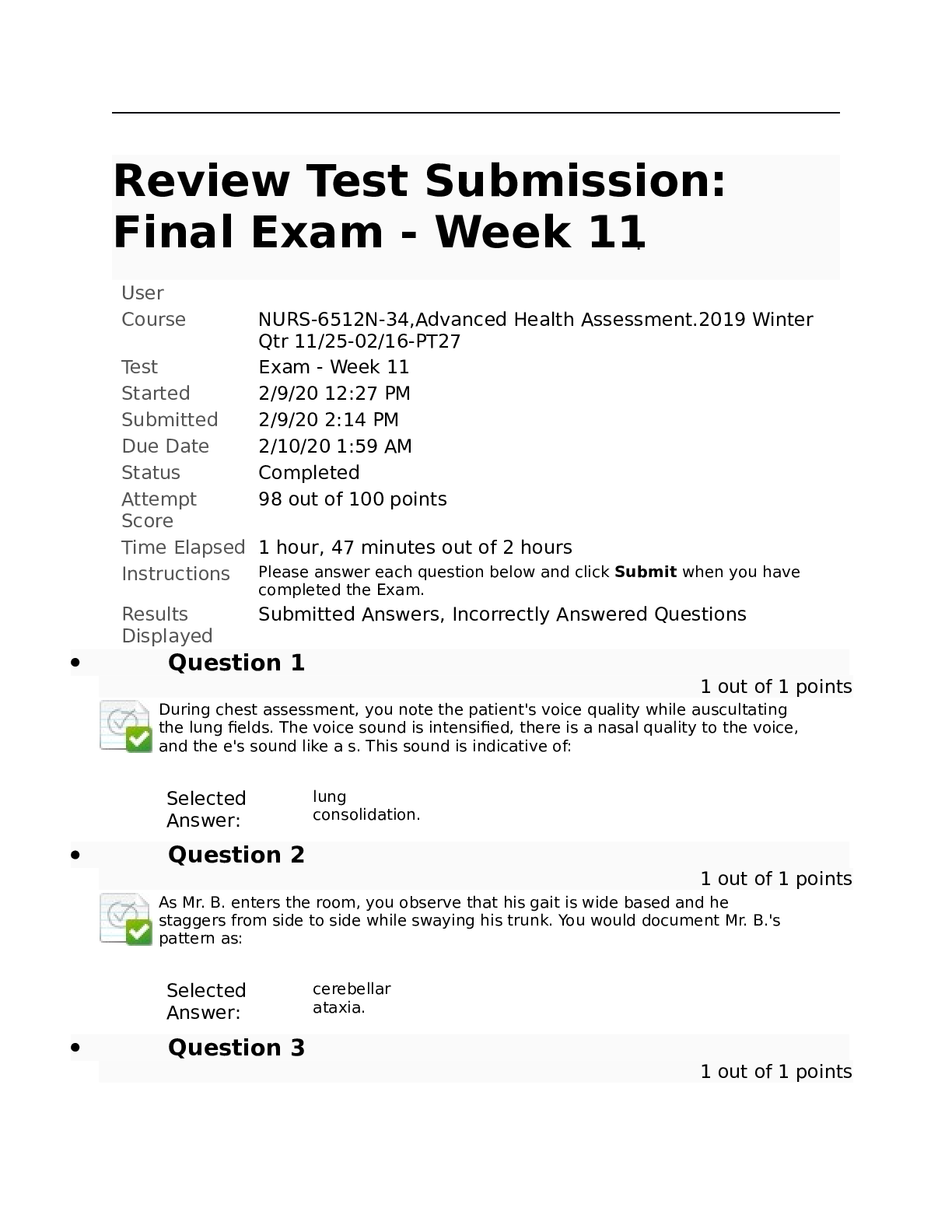
Reviews( 0 )
Document information
Connected school, study & course
About the document
Uploaded On
May 05, 2021
Number of pages
19
Written in
Additional information
This document has been written for:
Uploaded
May 05, 2021
Downloads
0
Views
45

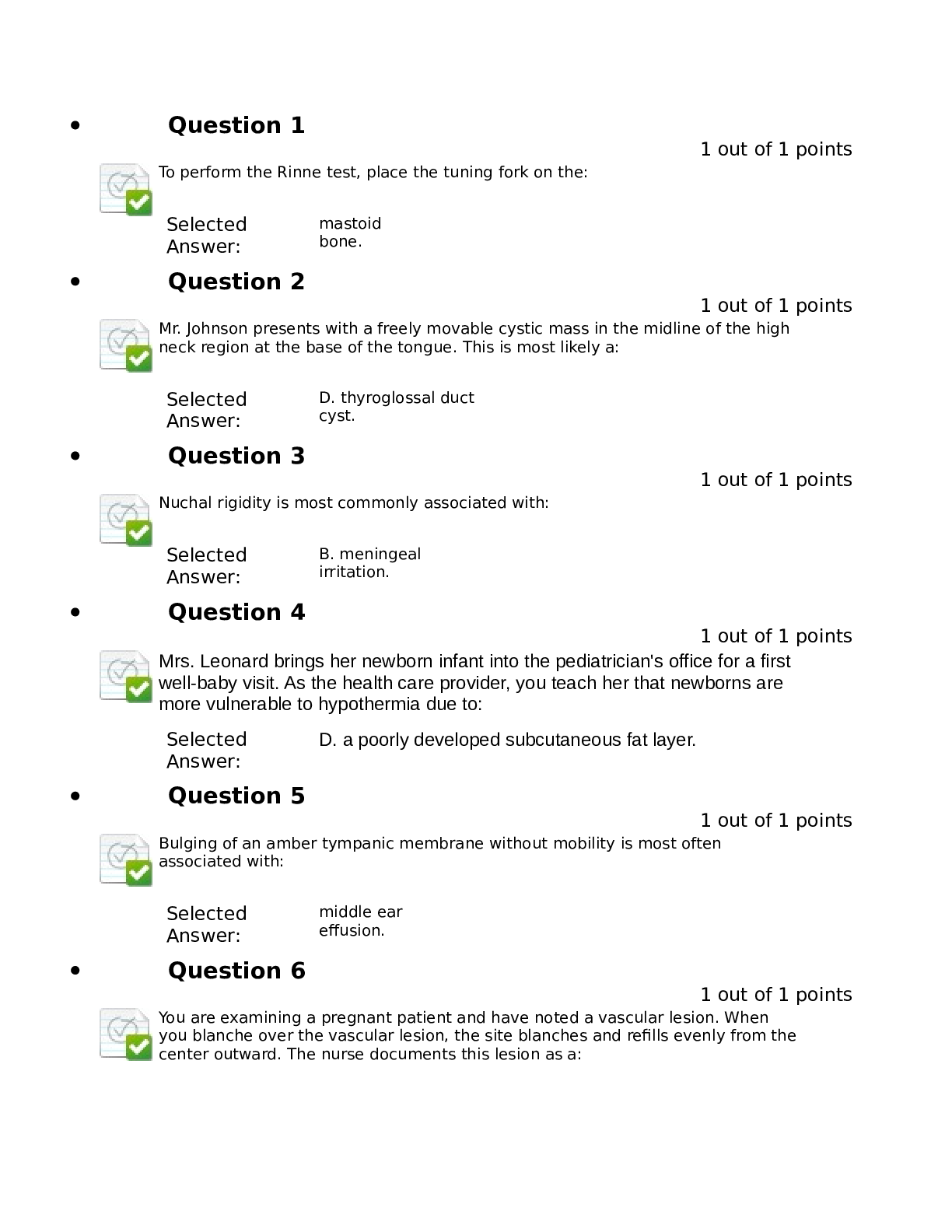
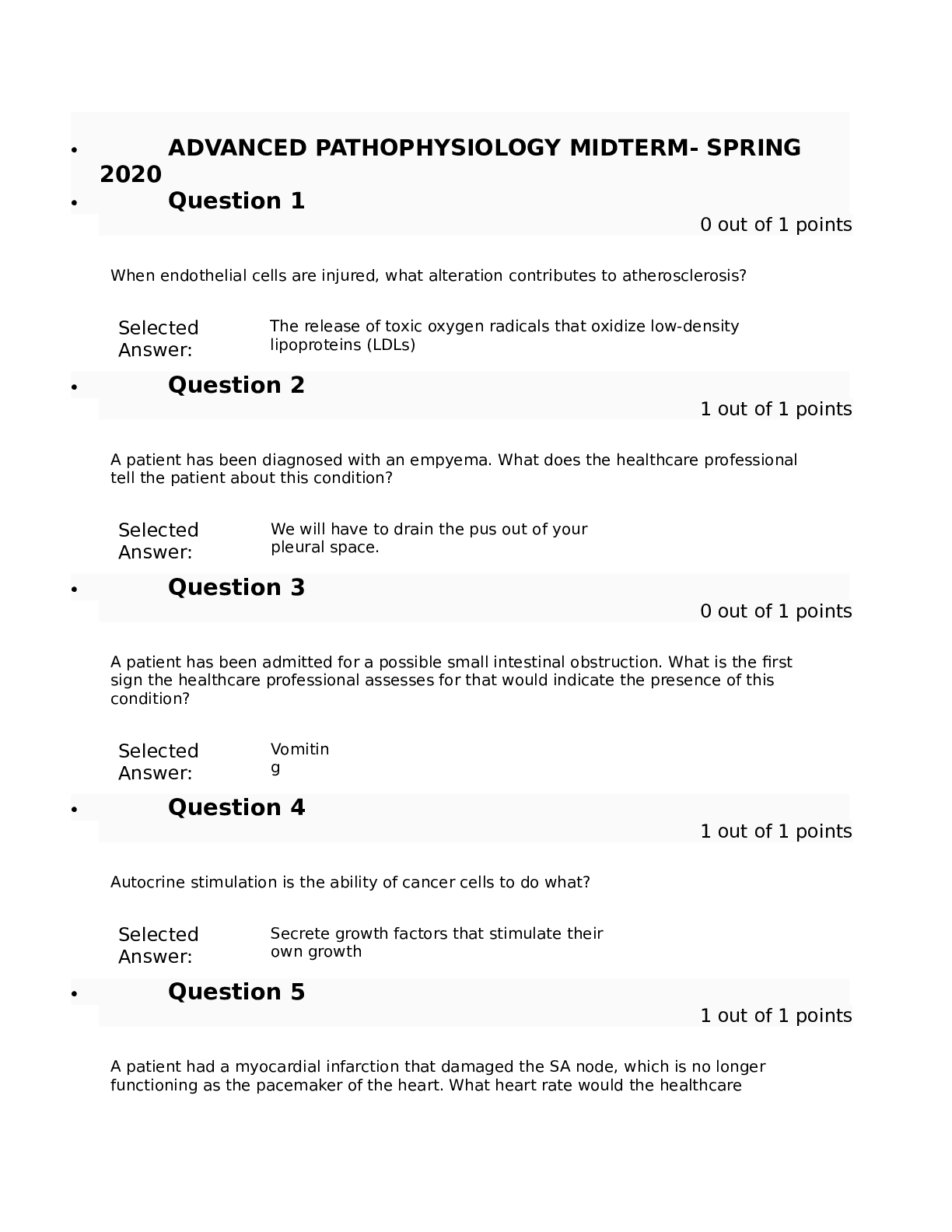
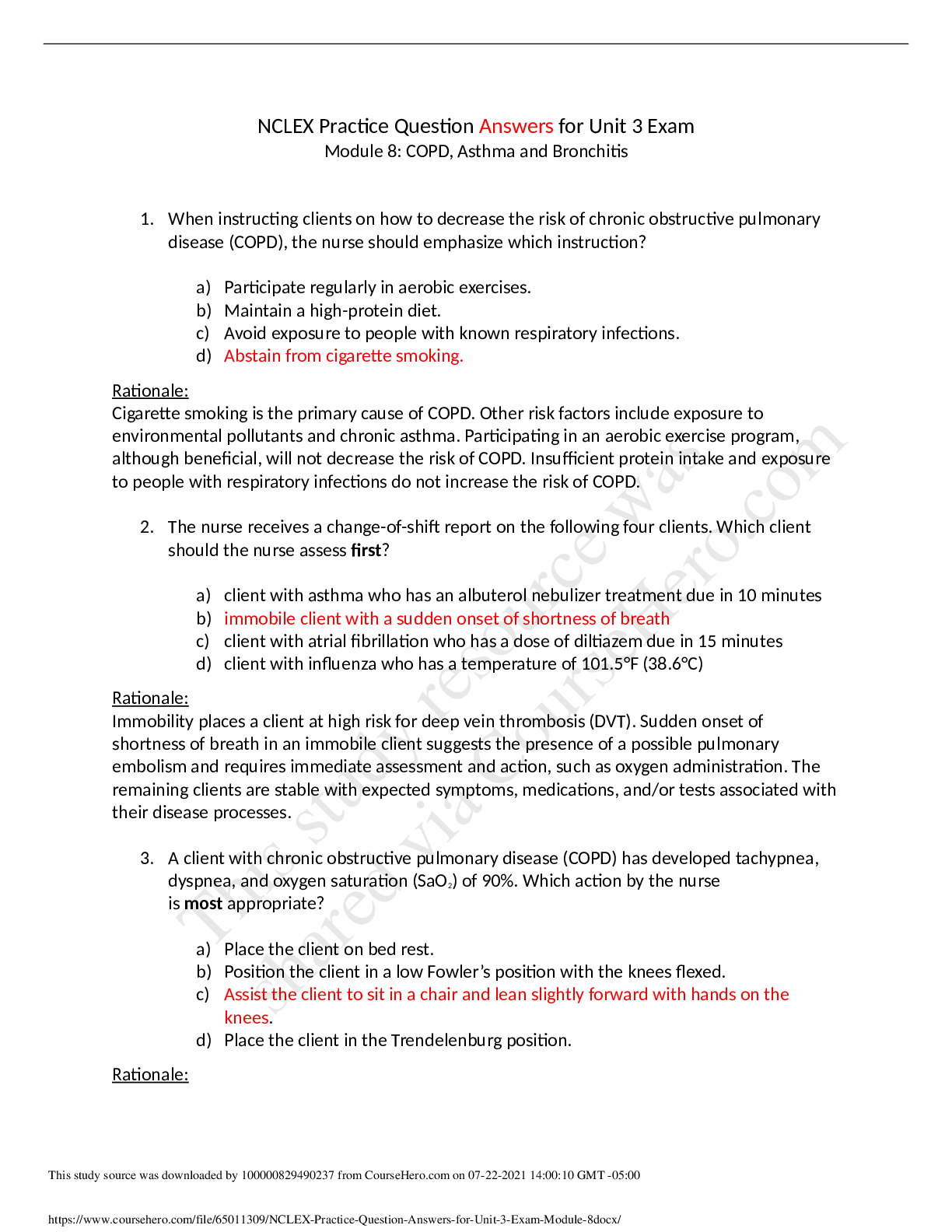
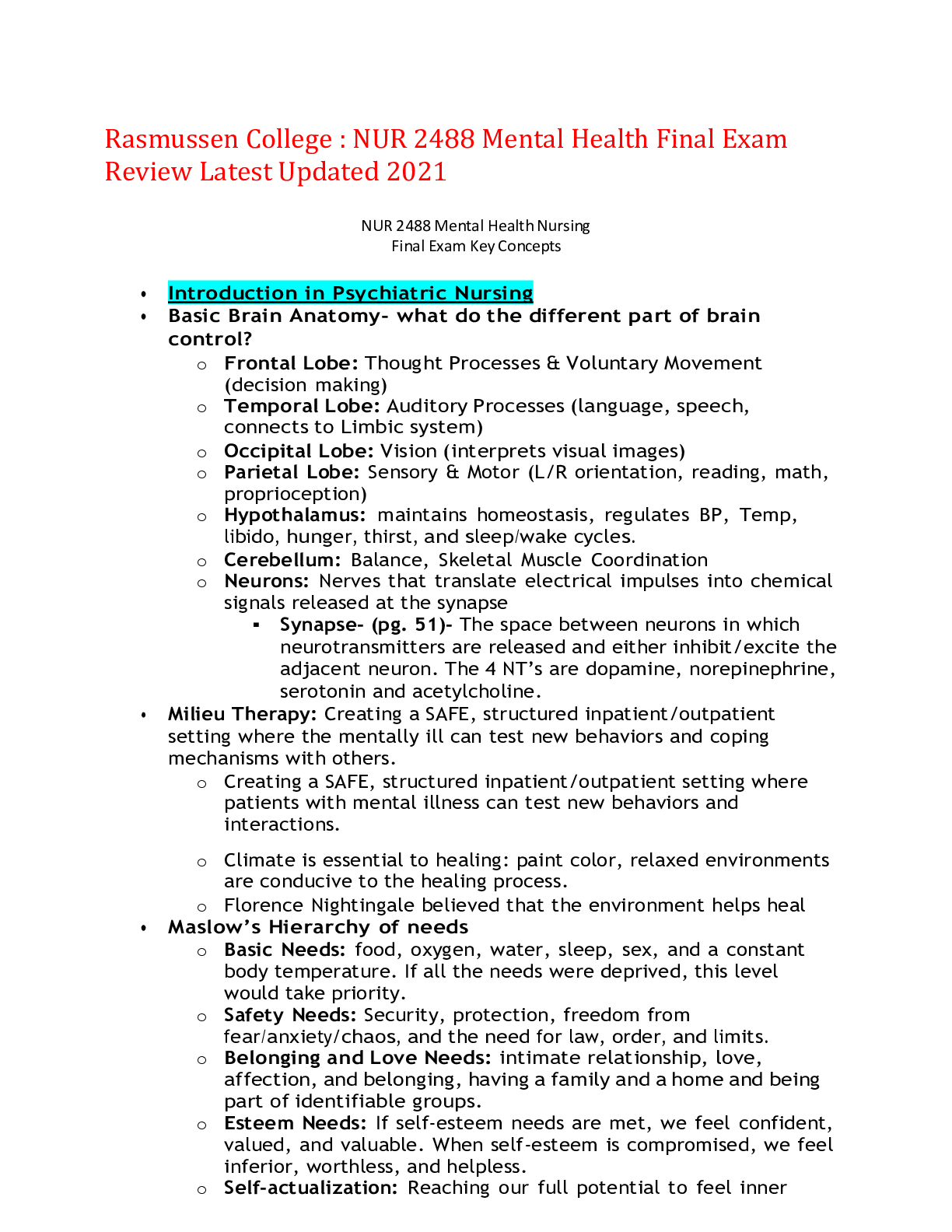
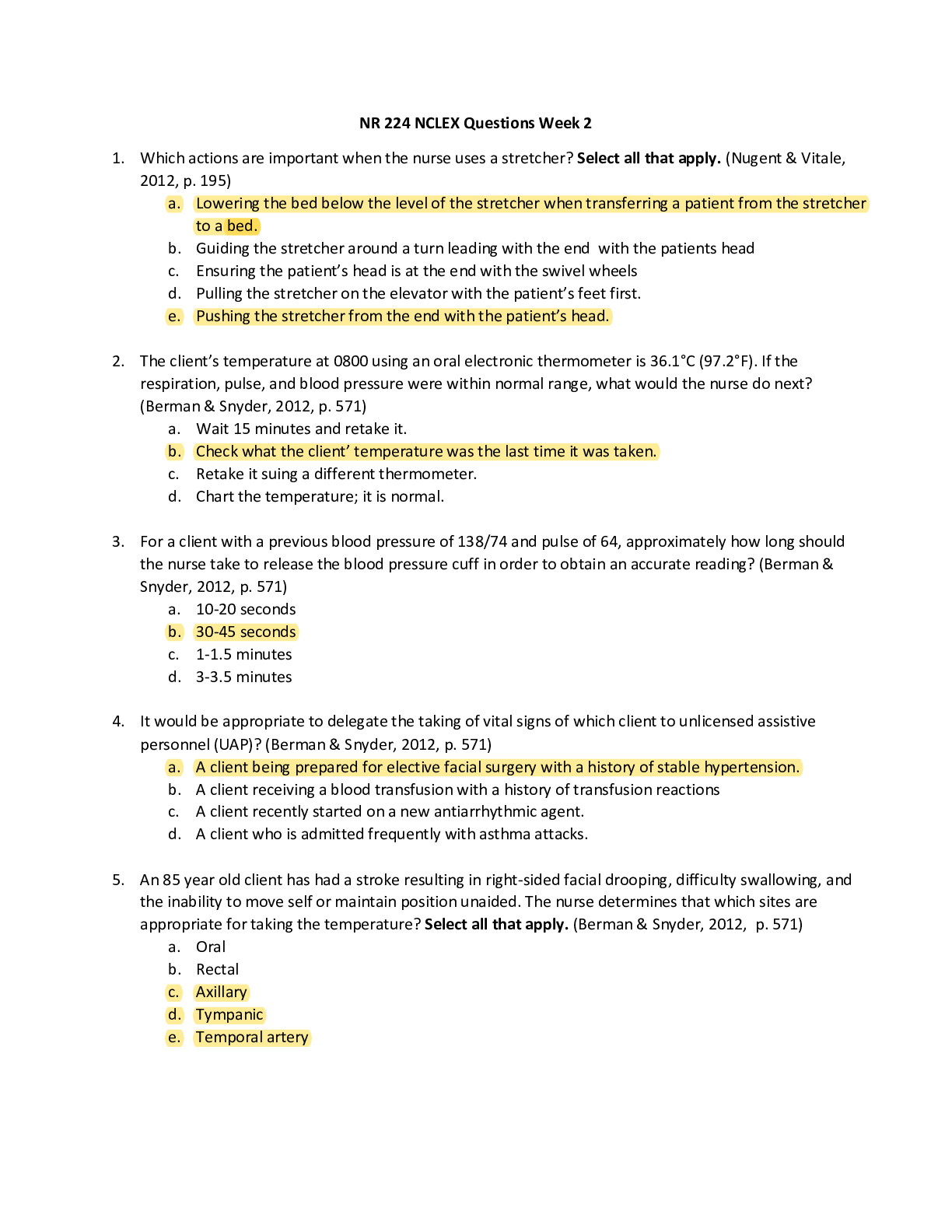
.png)
.png)
.png)

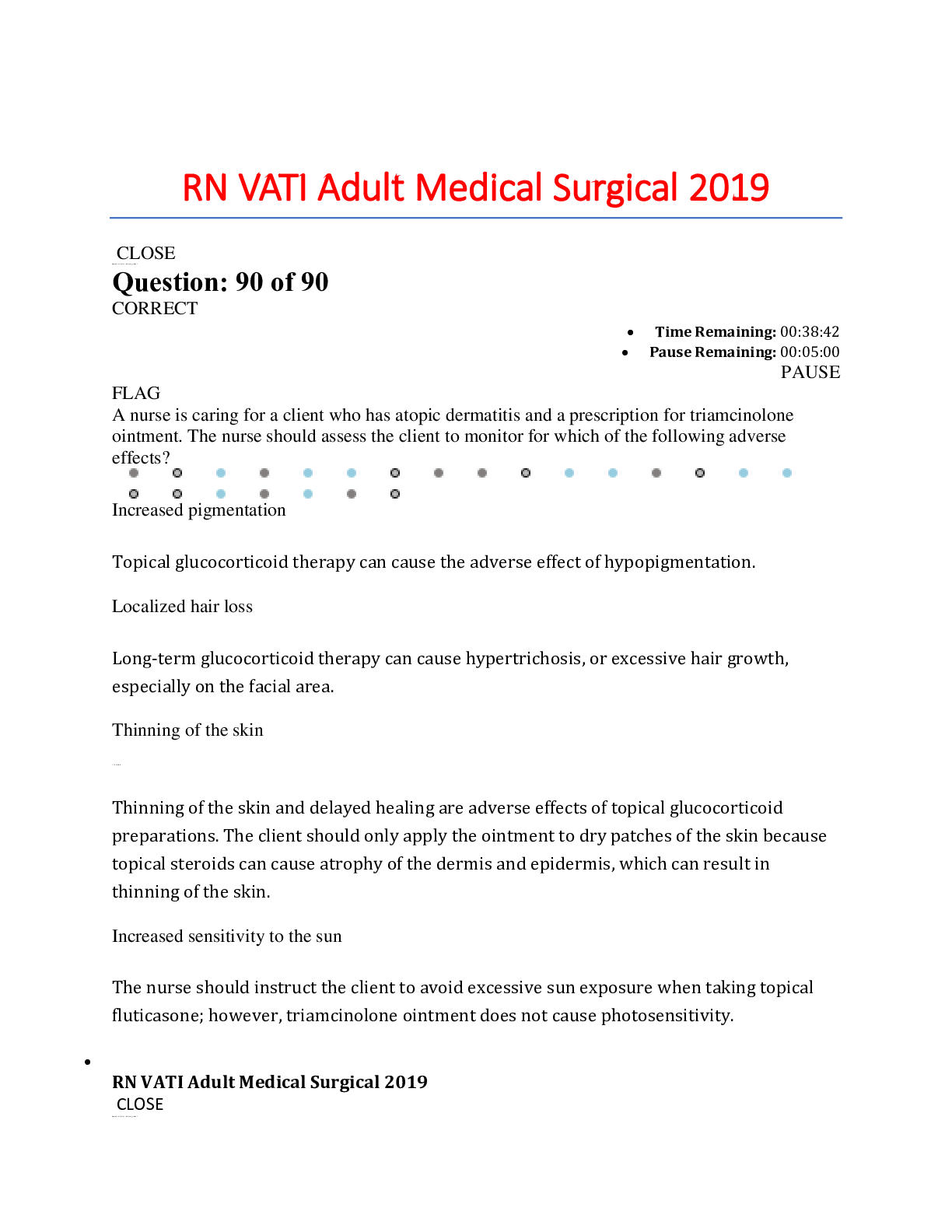
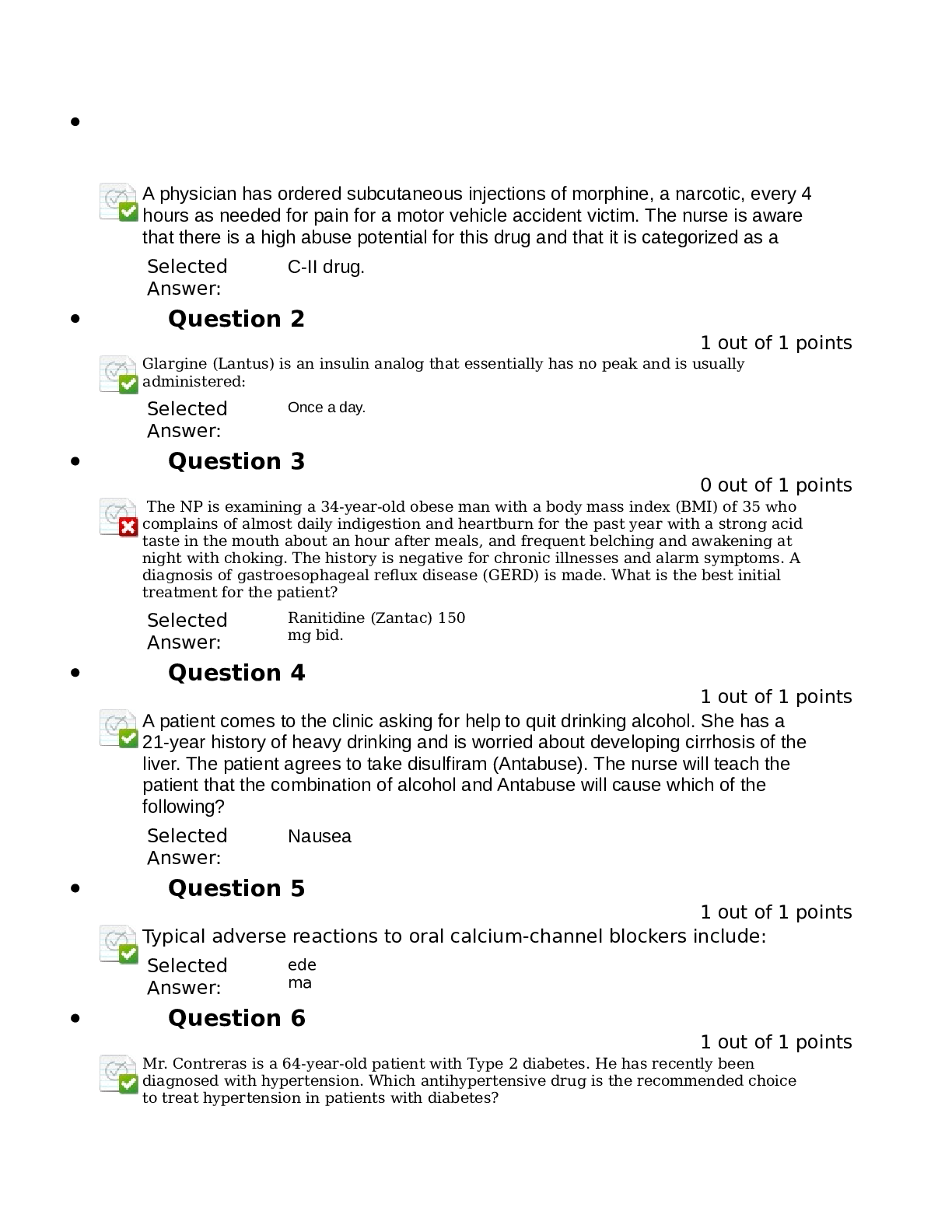
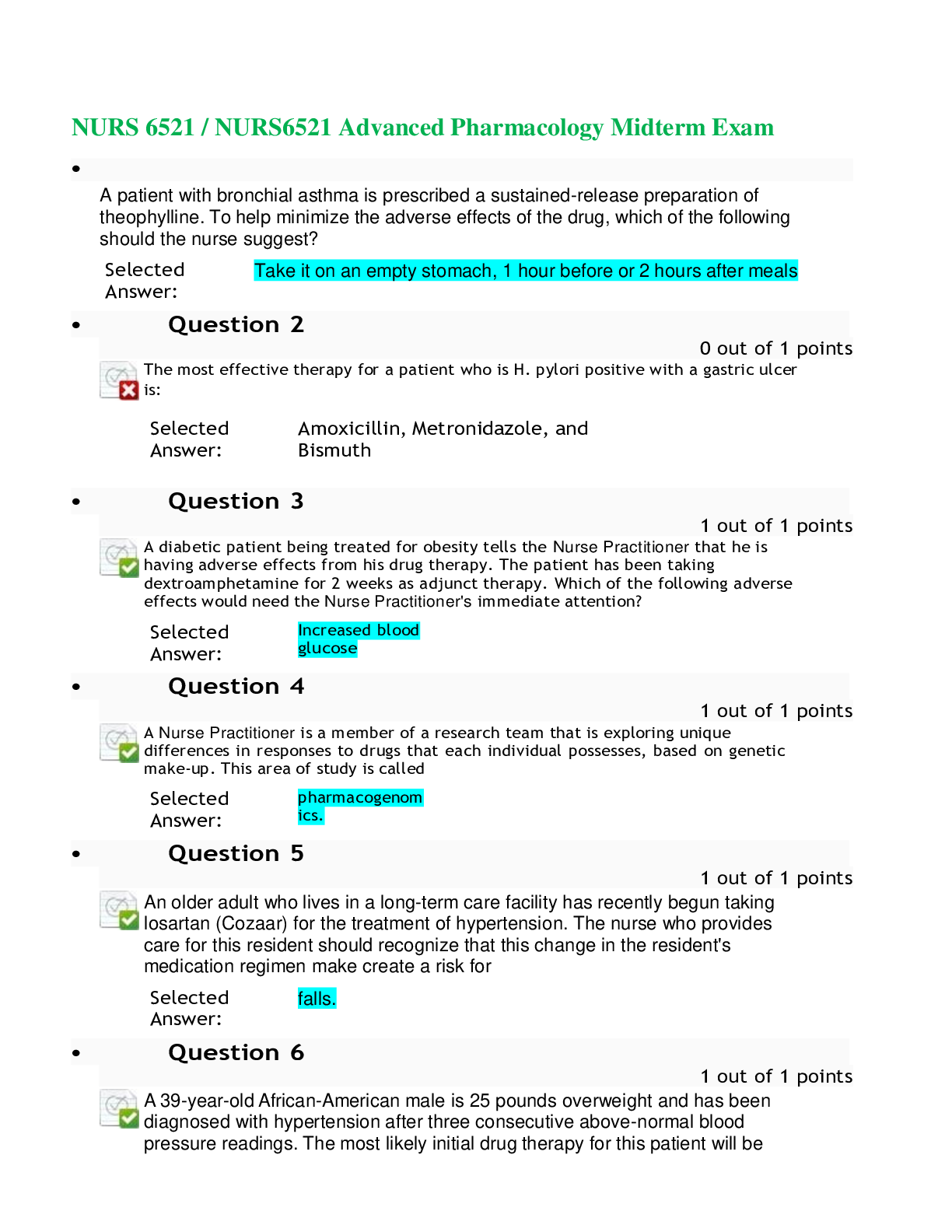

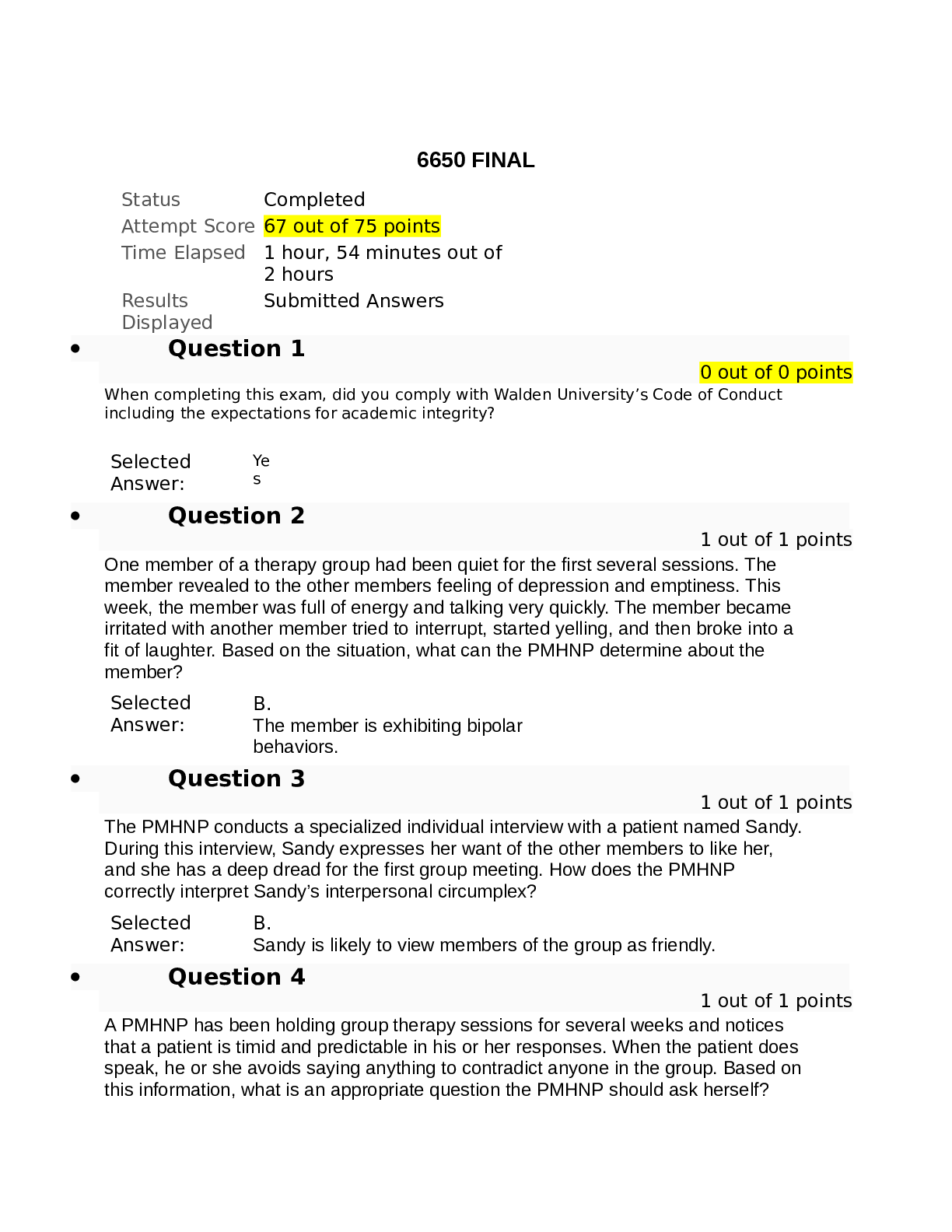
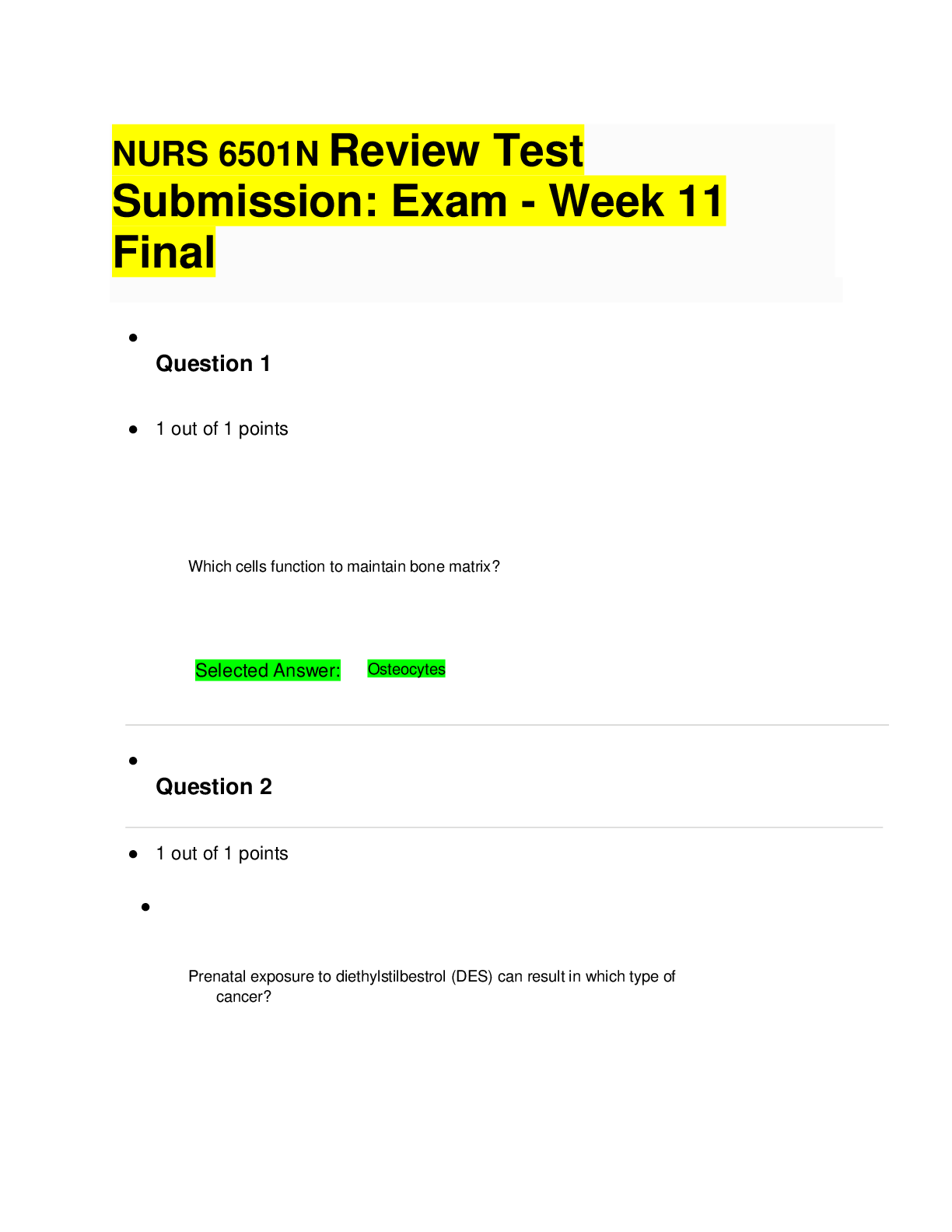

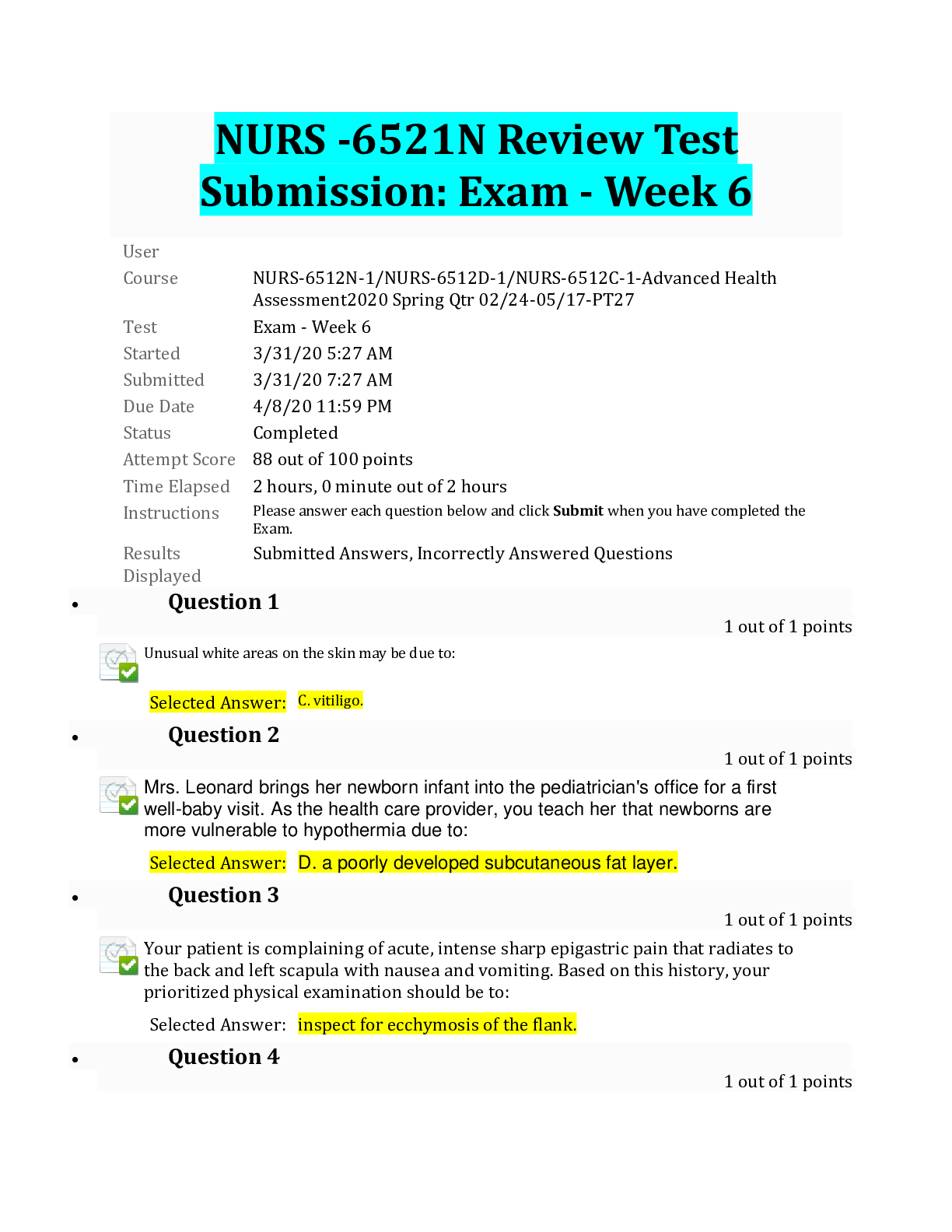
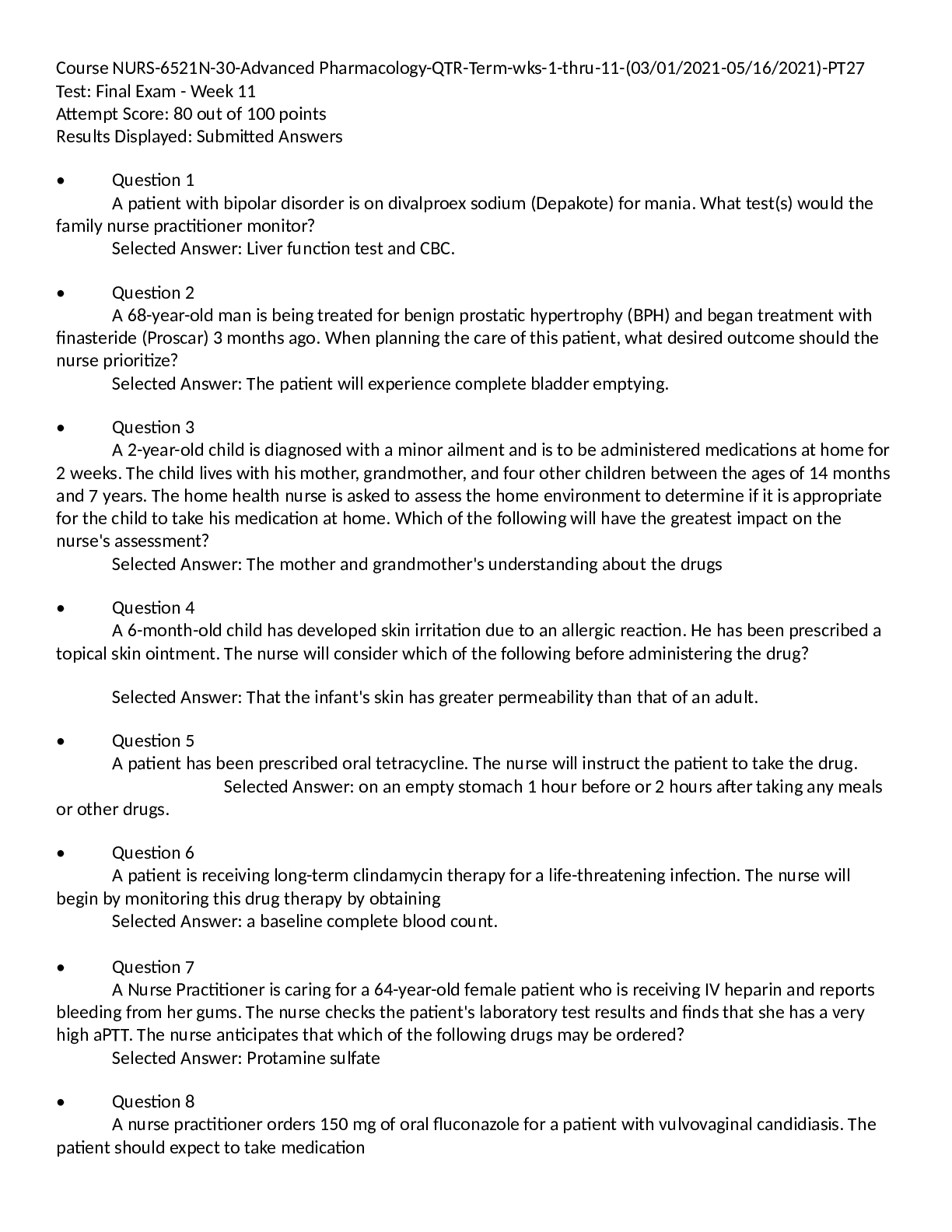

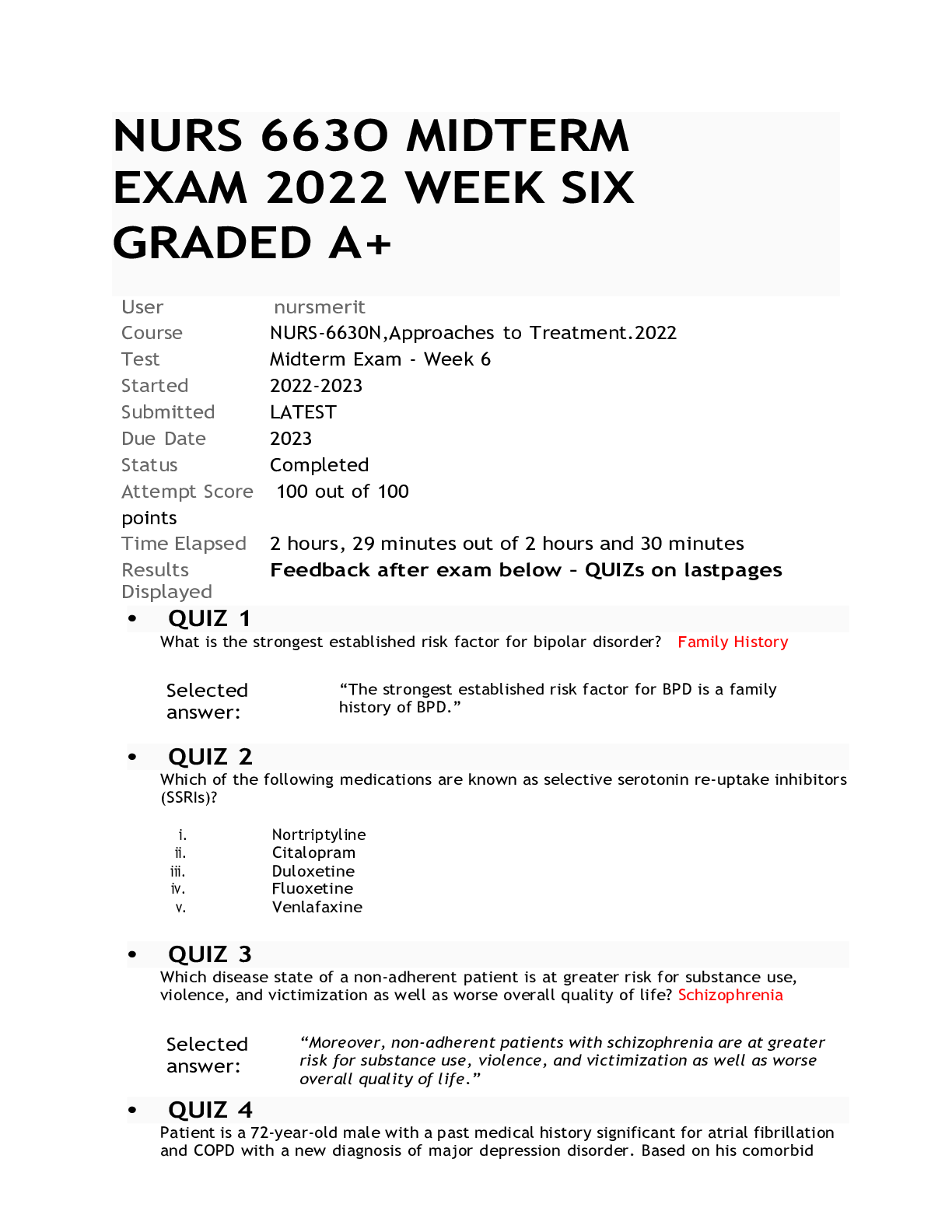
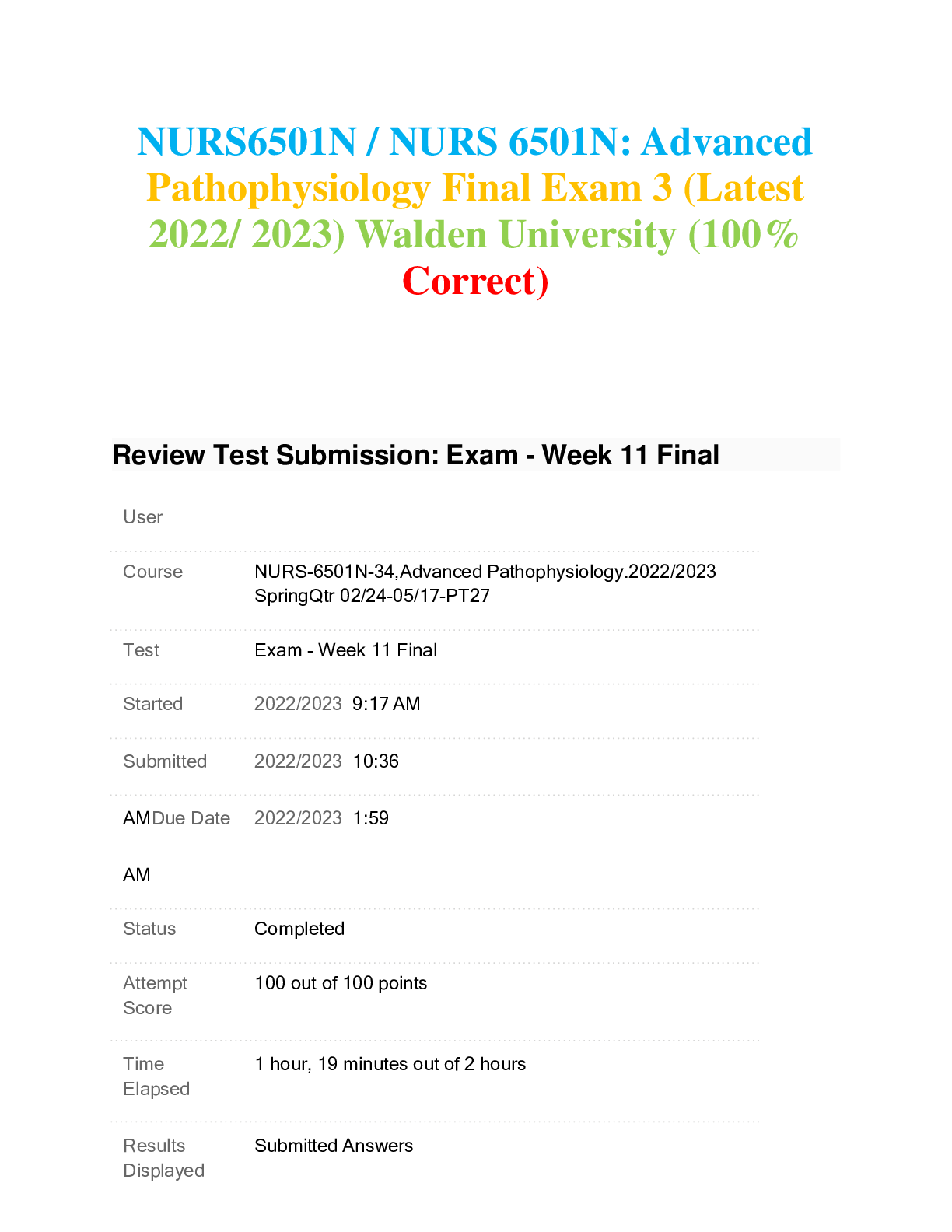
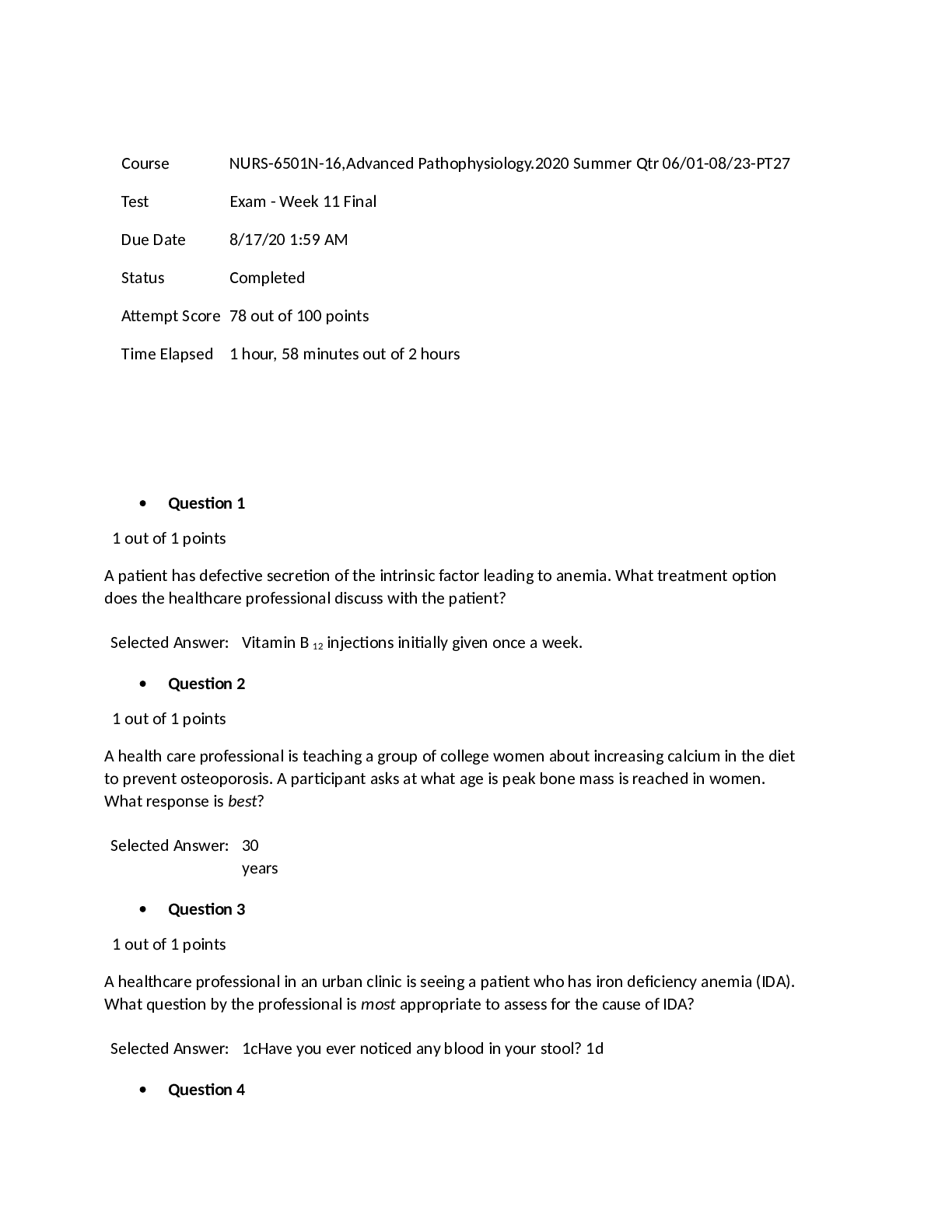
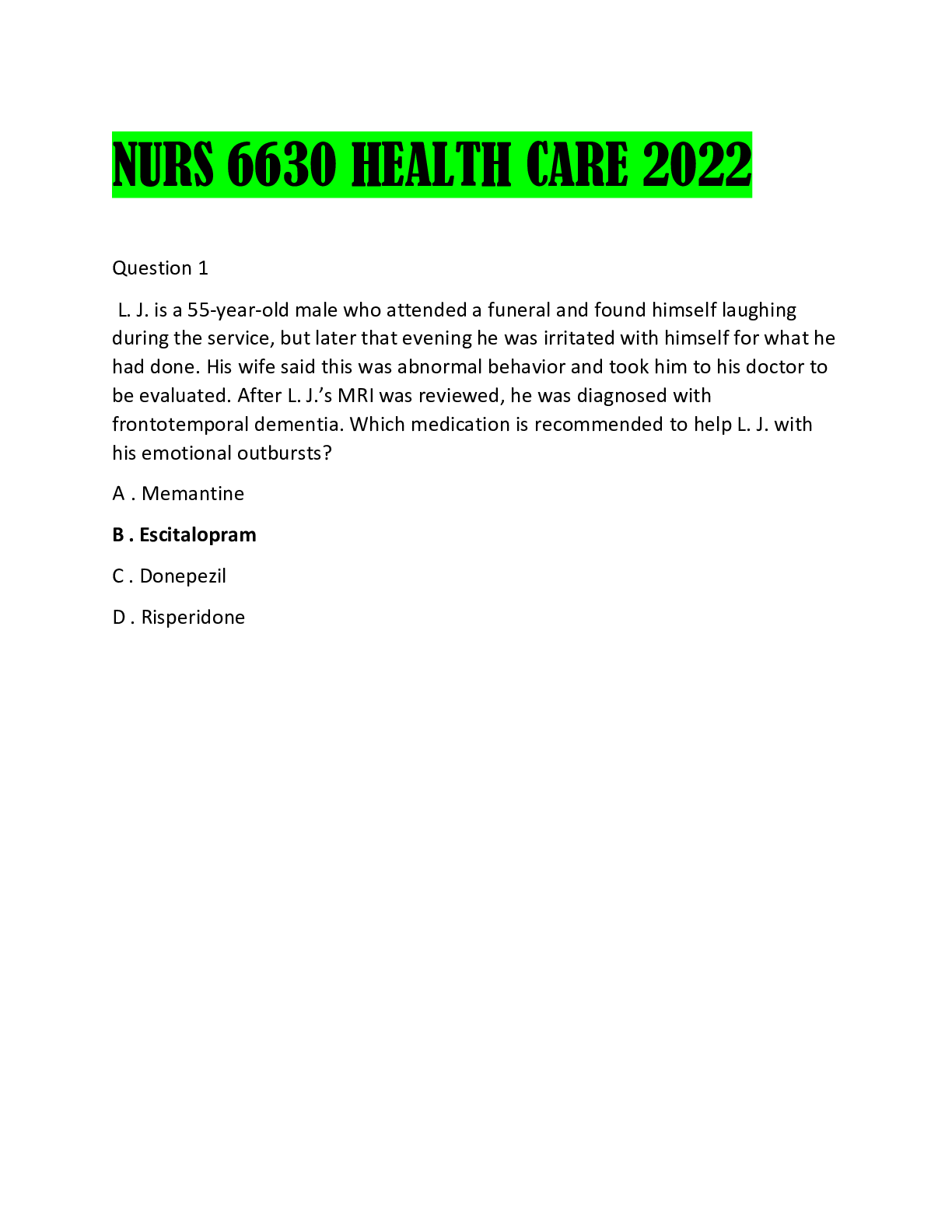
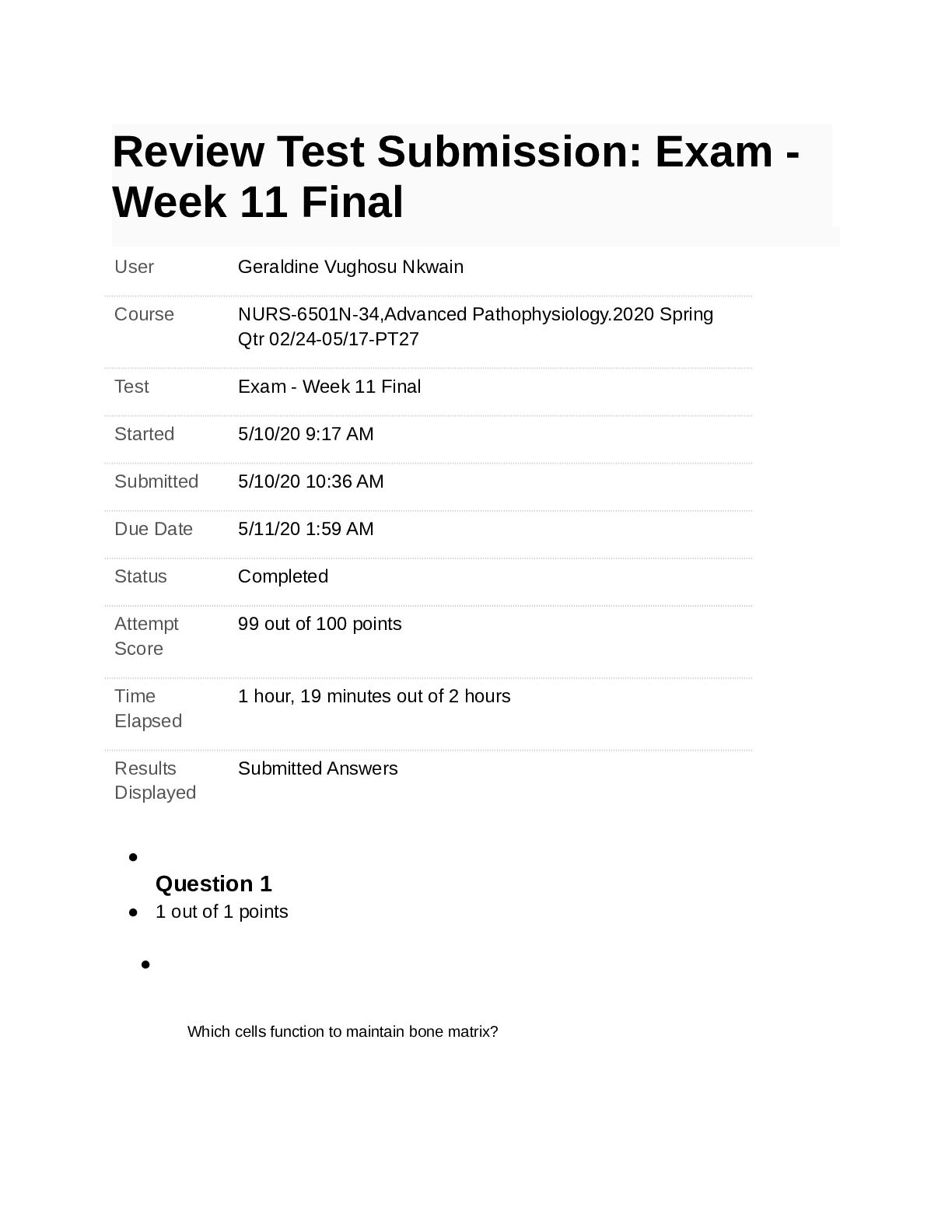
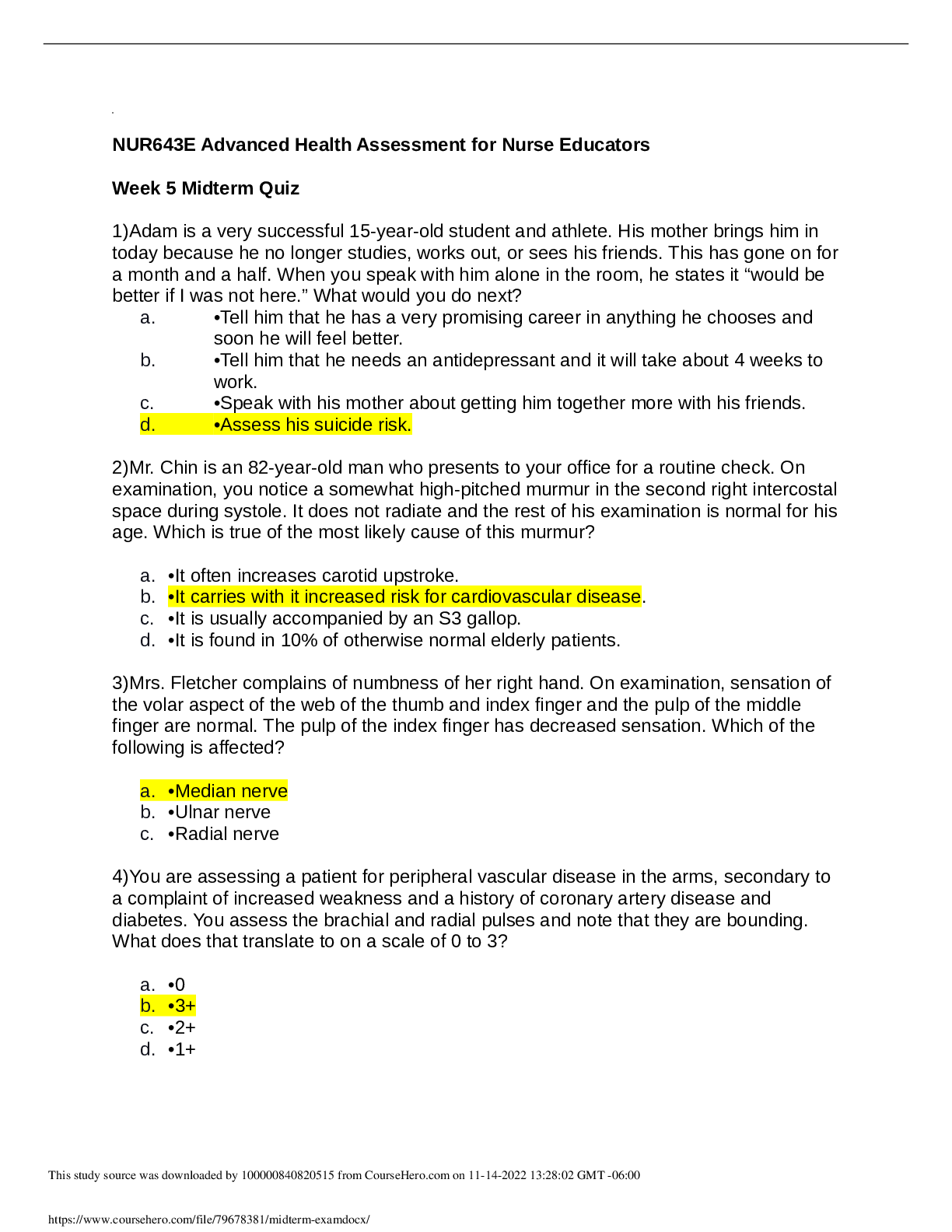
.png)

